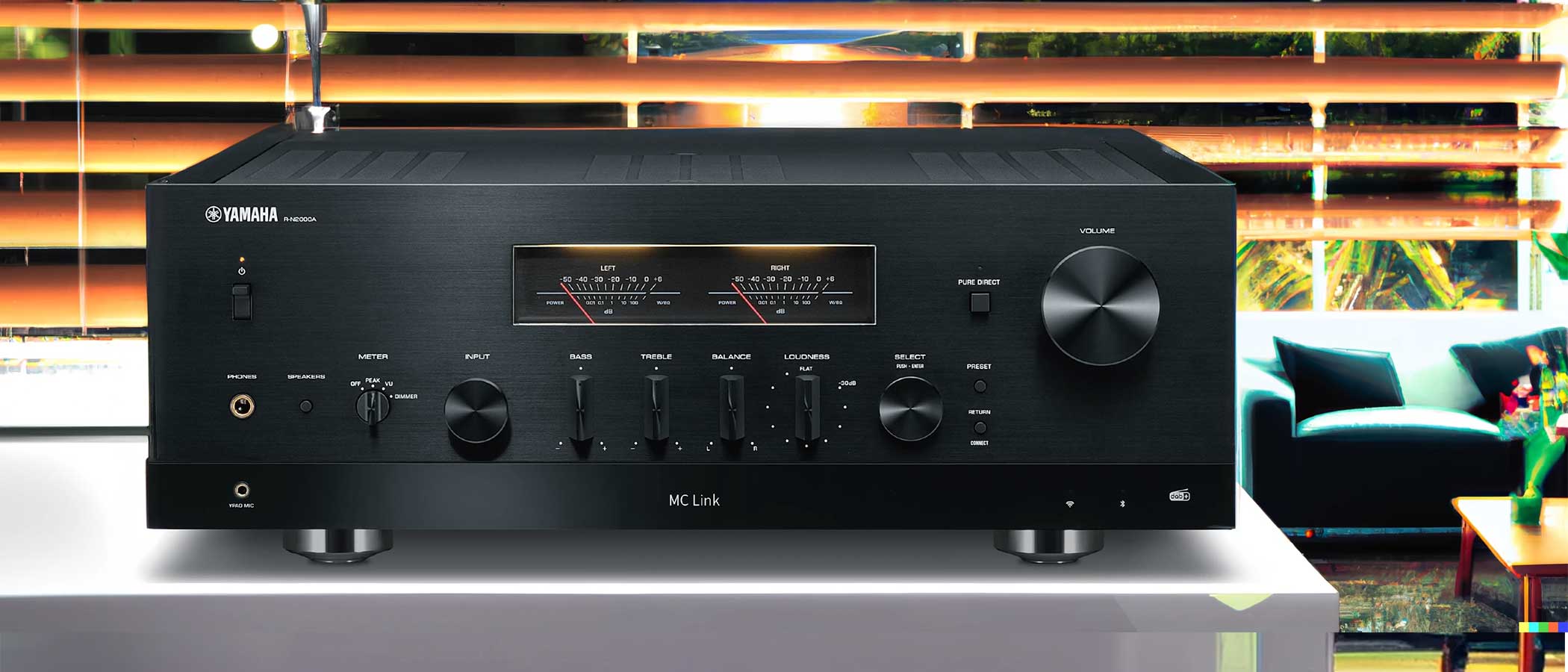Sound+Image Verdict
Yamaha's R-N2000A amplifier combines MusicCast streaming and app control with a relatively purist modern take on a classic amplifier. It’s a magnificent release from Yamaha
Pros
- +
Solid analogue amplifier performance
- +
MusicCast streaming & multiroom
- +
YPAO room correction
- +
Versatile inputs
Cons
- -
Old-school looks may not be for all
Why you can trust What Hi-Fi?
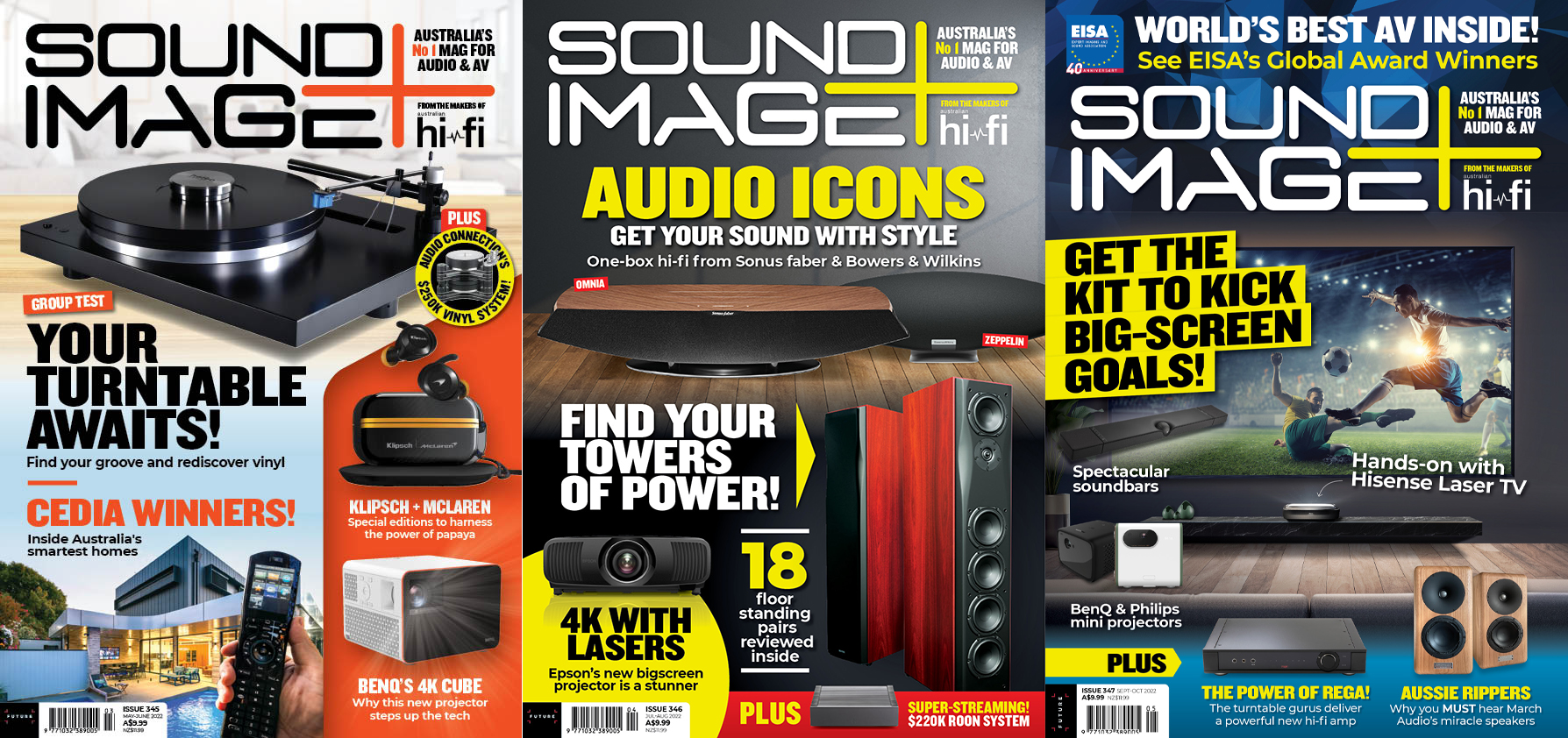
This review originally appeared in Sound+Image magazine, Australian sister publication to What Hi-Fi?. Click here for more information on Sound+Image, including digital editions and details on how you can subscribe.
Yamaha has enjoyed a resurgence in two-channel stereo over the last decade, giving it full respect and full resources ever since a new flagship 5000 Series rolled out in 2016.
Back then we reviewed the NS-5000 loudspeakers, large beryllium-toting boxes referencing the glory days, as did the turntable which followed, ‘Giant and Tremendous’ like Yamaha’s turntables of old, along with the 5000 Series high-end power and preamps in classic Yamaha style.
Today, as we hopefully exit the trading trials of the pandemic period, we find Yamaha’s stereo range impressively stocked from affordable midrange hi-fi up to the 2000 Series of which this R-N2000A is part, and above to the 3000 Series which includes Yamaha’s flagship integrated amplifier (the AU$9999 A-S3200), topped only by the separate amps of that flagship 5000 Series.
It is notable that all of those are fully analogue amplifiers; indeed the 5000
Series is a fully analogue system from end to end, while the 3000 and 2000 Series have CD players that can also add digital inputs to the system.
When the 5000 Series was launched we had the opportunity to ask Mr Susumu Kumuzawa, Yamaha’s head of hi-fi development, about this all-analogue focus. Partly, he explained, it was based on circuit design, not wishing to compromise the symmetrical ‘folding book’ design of the 5000 Series preamp. The addition of a digital circuit would have prevented this ideal from being achieved, Mr Kumuzaya told us, so these functions were better left to an external source device.
“We have confidence in our other systems — of course we have the technology of MusicCast and many DSP technologies,” he told us. “But what we wish to express in our flagship hi-fi is the focus on dynamics and energy, ‘True Sound’ musicality. We’ve focused on this concept, and the turntable has a very smooth and emotional sound.”
Note ‘True Sound’ – Yamaha has since adopted this as a motto across its audio ranges, defining it as “sound as it was meant to be heard: sound as the artist, the producer, the composer, the creators intended”.
Different to ‘Natural Sound’, then?
“Natural Sound means maybe the character of the sound,” Mr Kumuzaya told us. “But True Sound has a more conceptual meaning, and includes the actual experience with music – so making waves, waves in your heart. True Sound is our higher priority keyword to cover all our products.”
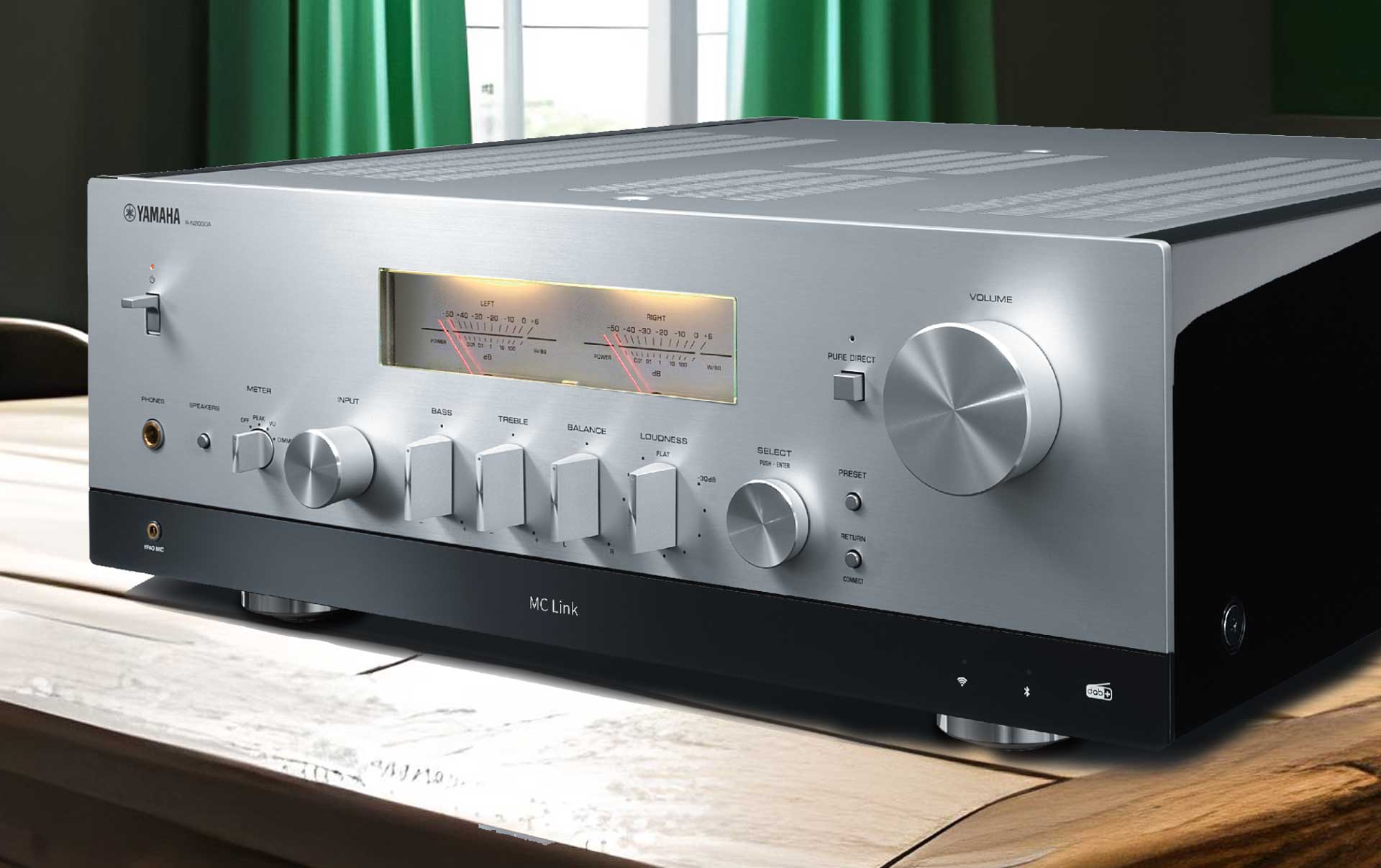
Design & build
As noted, then, fully analogue amplifiers are all very well if you have a separate CD player or media player which can do the heavy digital lifting.
But many 21st-century users will not want to be shelling out for a CD player, because they have no interest in silver discs, having shifted their musical consumption to streaming or file-based replay.
This is precisely why the smart amplifier has become such a plat du jour. Take an amplifier, add a DAC for digital inputs, along with networking to allow direct streaming of music from the internet, and playback of digital files either locally or across the home network.
And that, in a nutshell, with some other bits outside the nutshell, is the R-N2000A. We’d call it a smart amplifier: Yamaha has gone with ‘networked receiver’, which is technically correct since this is an amplifier with radio tuners (FM and DAB+), and if this was 1975 we wouldn’t have a problem with the term; we just wonder how many people today will see ‘receiver’ and think ‘surround’.
One key consideration with a smart amplifier (or receiver) is how you incorporate their smarts. How ‘in-yer-face’ do you make the modern stuff?
Yamaha’s answer is ‘not much at all’. So while some smart amps are fronted by a giant colour touchscreen proclaiming their modernity, Yamaha has, we think, been marvellously subtle in the merging of analogue and digital here, the way it has combined traditional and modern.
Clearly the R-N2000A looks every bit as classic as the un-digital amplifiers in Yamaha’s ranges. With its backlit VU meters and long vertical toggle switches, the R-N2000A fully maintains the Yamaha styling that, amazingly, dates all the way back to a 1954 tuner designed by the legendary Kenji Ekuan from GK Design, then Group of Koike. GK also worked with Yamaha on motorbikes and electronic keyboards; Kenji Ekuan also come up with the Kikkoman soy sauce bottle, an unchanged design icon since 1961.
The original Yamaha aesthetic gained full expression in the 1973 CA-1000 amplifier (pictured below in its 1977 edition); this had further input from GK Design. Look at the CA-1000; look at the R-N2000A. They’re 50 years apart. But it’s not nostalgia, as such. It’s just, why would you want to change things?
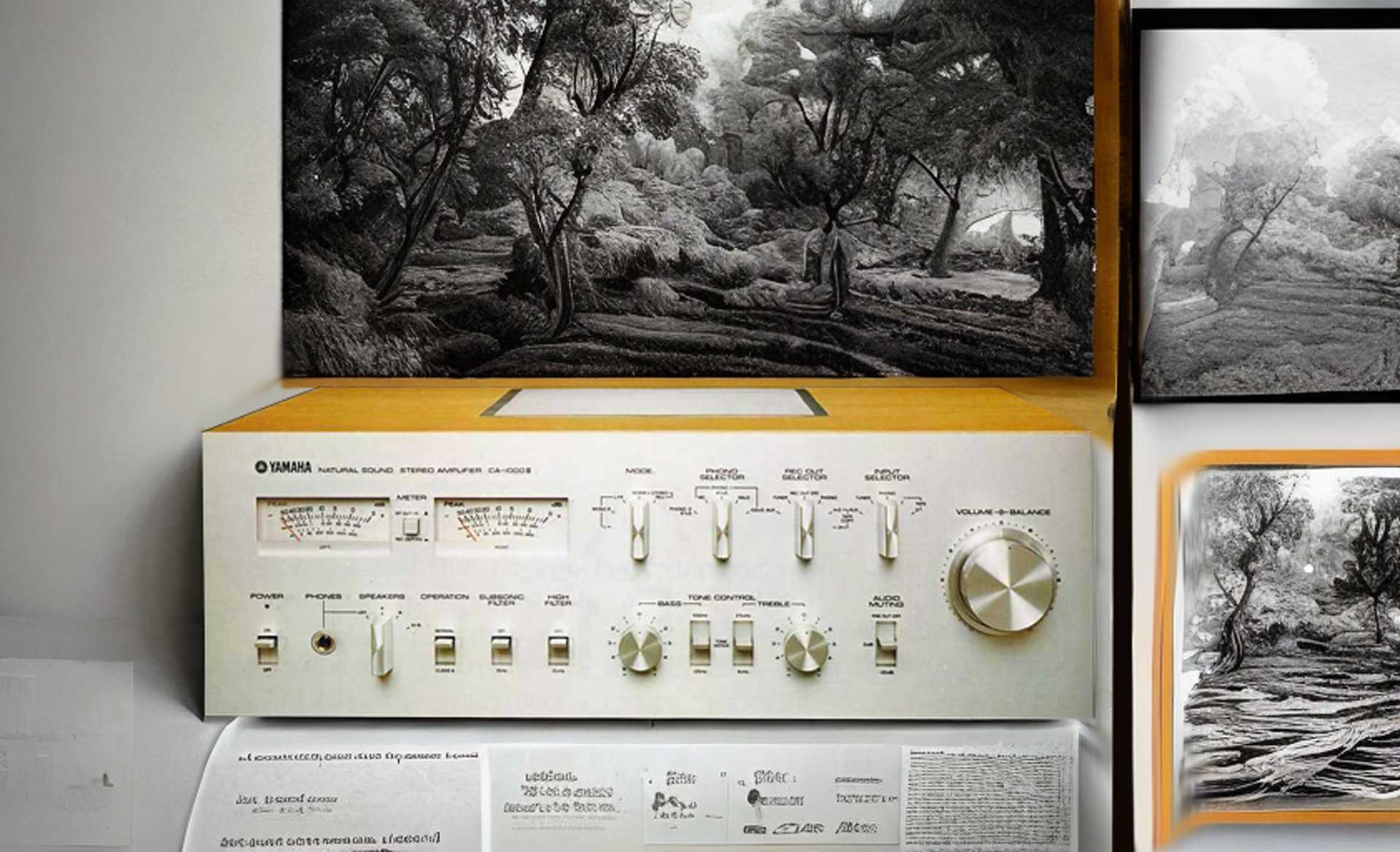
Features

Power: 2 × 90W into 8 ohms (20Hz–20kHz, 0.07% THD)
Inputs: phono, 3x line-level analogue, 2x optical digital,
coaxial digital, USB-B, HDMI ARC, Ethernet, Wi-Fi, MusicCast, AirPlay
Outputs: subwoofer out, 4x speakers out
Dimensions (HWD): 15.7 x 43.5 x 47.3cm
Weight: 22.1kg
Classic as it looks, the R-N2000A incorporates not only a DAC and digital inputs, not only networking and streaming, but a full implementation of Yamaha’s MusicCast streaming and multiroom platform.
The MusicCast platform includes the MusicCast app for iOS and Android devices, allowing fingertip control of the amplifier and its streaming sources, and also multiroom control, with this amplifier able to send its music to any other MusicCast-equipped Yamaha products in the home, or to stream a music service simultaneously to multiple zones.
The smarts are all hidden very well. Look at the bottom of the amplifier and you’ll notice a black strip underneath the main fascia. It looks a little plasticky compared with the brushed aluminium above, but at its centre is a little white-on-black display which illuminates to show input and other information.
It’s a slight digital intrusion into all the analogue loveliness, but very sympathetically slipped under the main frame.
Perhaps we should not be surprised at such neatness, given that Yamaha was by far the most innovative of the companies launching streaming and multiroom platforms in the wake of the success of Sonos. Most rivals simply mimicked the Sonos ecosystem (though we should be careful how much we say about that, given that an Australian colleague’s comments along these lines ended up being logged as evidence in a massive US court battle).
Yamaha, anyway, did very different things. It launched wall-clock speakers with MusicCast inside, proper stereo speakers, and even a grand piano (a self-playing Disklavier to be precise) with MusicCast.
So hiding a MusicCast module under an amplifier must have seemed a relatively straightforward proposal. It works beautifully. Each time we decamped to the music room, there sat the Yamaha amplifier (receiver, sorry) glowing away in analogue glory, and only when we pressed the remote control would that little strip at the bottom give the digital game away.
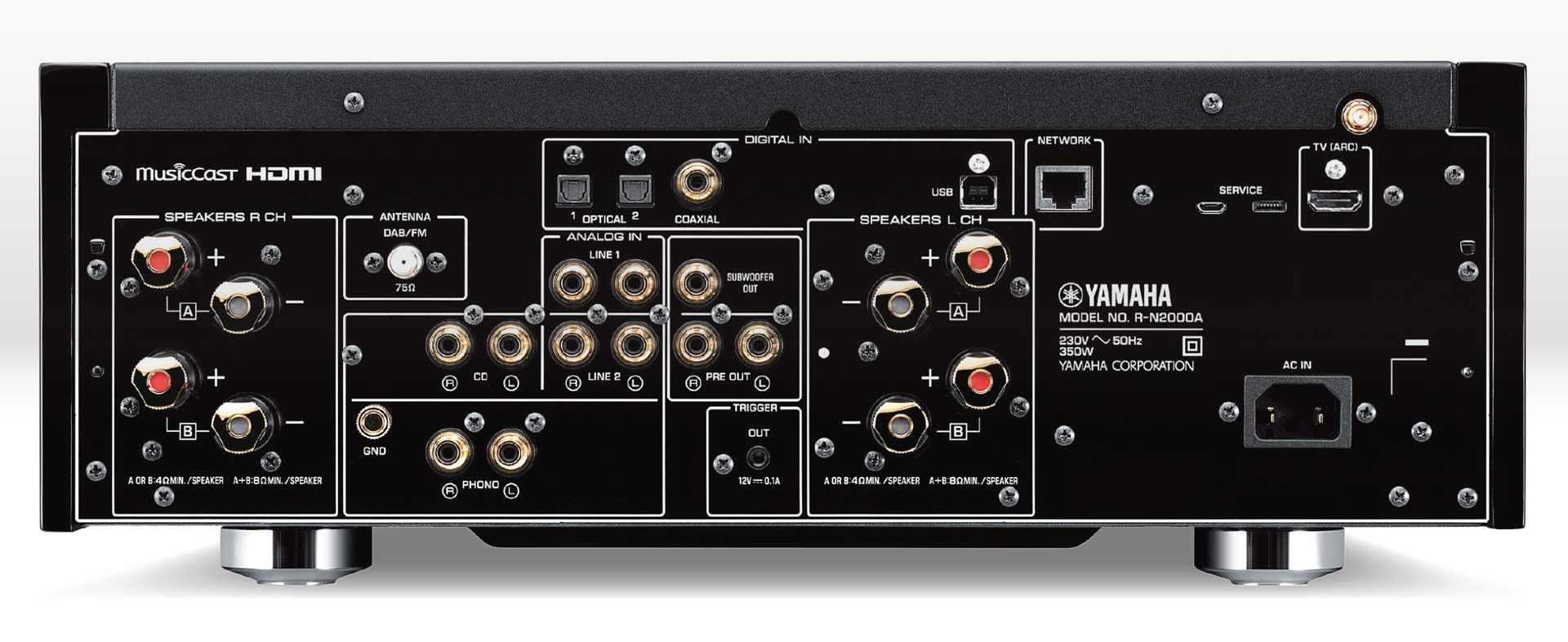
Connectivity
So in terms of physical inputs, the back panel tells the story.
There are three line-level analogue inputs, one of which is labelled CD, and there’s a phono-level input suitable for a turntable with a moving-magnet cartridge.
Above those are four digital inputs: two optical, one coaxial, and a USB-B socket for connecting a computer. Thanks to the use of an ultra-precision clock, this last hits the heights so far as file types go, capable of up to 32-bit/384kHz PCM (and including at 88.2kHz multiples) and stereo DSD to 11.2MHz/DSD256), compatible with ASIO Native and DoP delivery.
There’s one other digital input, tucked away at one side – a very useful HDMI socket capable of receiving audio down an HDMI cable connected to your TV’s ARC-compatible input. You’ll lose an input to your TV doing this, but it makes the R-N2000A a solid stereo solution for TV sound as well as music.
Other physical sockets include the FM antenna socket, a 12V trigger, a single mono subwoofer out, and a pair of pre-out RCAs which could be used to add additional power.
There’s also Ethernet networking, along with wi-fi; either will activate the whole MusicCast caboodle and also allow AirPlay streaming. There is Bluetooth in two directions, too – inward to stream music from a personal device, and outward to, most likely, a pair of Bluetooth headphones, though you could equally connect a Bluetooth speaker. Note that Bluetooth is limited to SBC and AAC codecs, so you’ll be well below CD quality via Bluetooth. And with Apple limiting most AirPlay use to 256k AAC, you will get better results using the MusicCast app to access on-device files.
The MusicCast app also gives direct access to internet radio, Amazon Music, Qobuz and Deezer, while the buttons for Spotify and Tidal open the full apps. Tidal used to open within MusicCast, where it had relatively simplistic folder-based browsing, so it’s good news that MusicCast has moved on to Tidal Connect; you can use the full Tidal app on your smart device, but the stream will play straight to the Yamaha.
The last sockets on the rear are the speaker binding posts – massive and solid brass ones, suitable for bare wire, spades or bananas. There are eight of them, four on each side, since there are two sets of speaker connections, and you can switch between set A, B, or A+B. The last option will be useful if you’re bi-wiring, but beware of driving two different sets of speakers, as you halve their impedance as seen by the amp. Yamaha says not to do it unless both pairs of speakers have an impedance of at least 12 ohms. And we don’t see many of those.
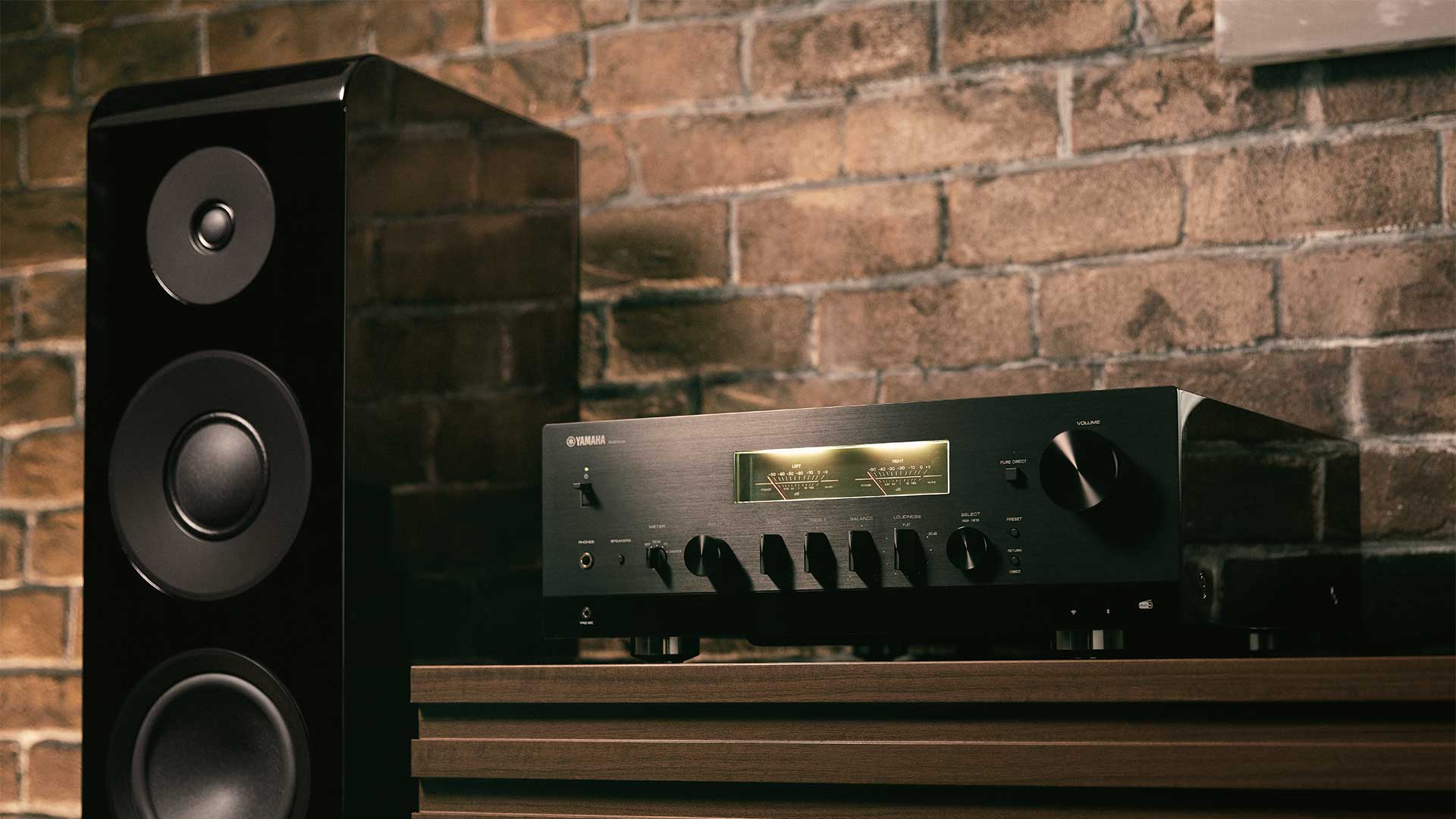
The selection of speakers A, B or A+B is made by a little button on the front panel, just right of the full-size headphone socket, which sits directly below the main power switch.
Most people will call this power switch ‘upsidedown’, because up is on, and down is off. We have a colleague who really doesn’t like this arrangement, but we disagree, finding it immensely satisfying to sidle over to the Yamaha and slap down the switch to say good night. Down is off. Of course it is.
Except that you get a remote control and an app which can turn off power even when the amp switch is still up. Mmm. At least those can’t turn it on when it’s off; the 'off' switch is a real circuit breaker.
And after all, the remote control is a lovely solid aluminium wand, and for our money perfectly populated, every input having its dedicated button, and with volume and mute buttons clearly separated in a line at the bottom. Top marks.
Next along the front panel is a three-way switch to activate and control the behaviour of those VU meters, which can be switched between standard VU and peak display – the VU option grants the gentler motion, with more averaging of the signal, while peak display is faster and inevitably jumpier in action.
Past the little input selection knob come those vertical bar-knobs, adjusting bass, treble, balance and here also ‘loudness’, something you won’t see on the 3000 or 5000 Series, so presumably an addition that Yamaha feels young trendy streaming people might want. We oldies will be more drawn to the ‘Pure Direct’ button between the VU meters and the big medium-weighted volume knob.
A couple of selection buttons for menu navigation complete the controls complement, but down at the left of that black plastic modern strip underneath is a little minijack socket – not an alternative headphone socket but there to receive the supplied microphone to undertake Yamaha’s YPAO (Yamaha Parametric Room Acoustic Optimizer).
This aims to correct room acoustics, using 64-bit/192kHz EQ, and what the company calls RSC (Reflected Sound Control) to actively control the important early reflections. If your room is problematic, this could be a useful carryover skill from Yamaha’s multichannel receivers.
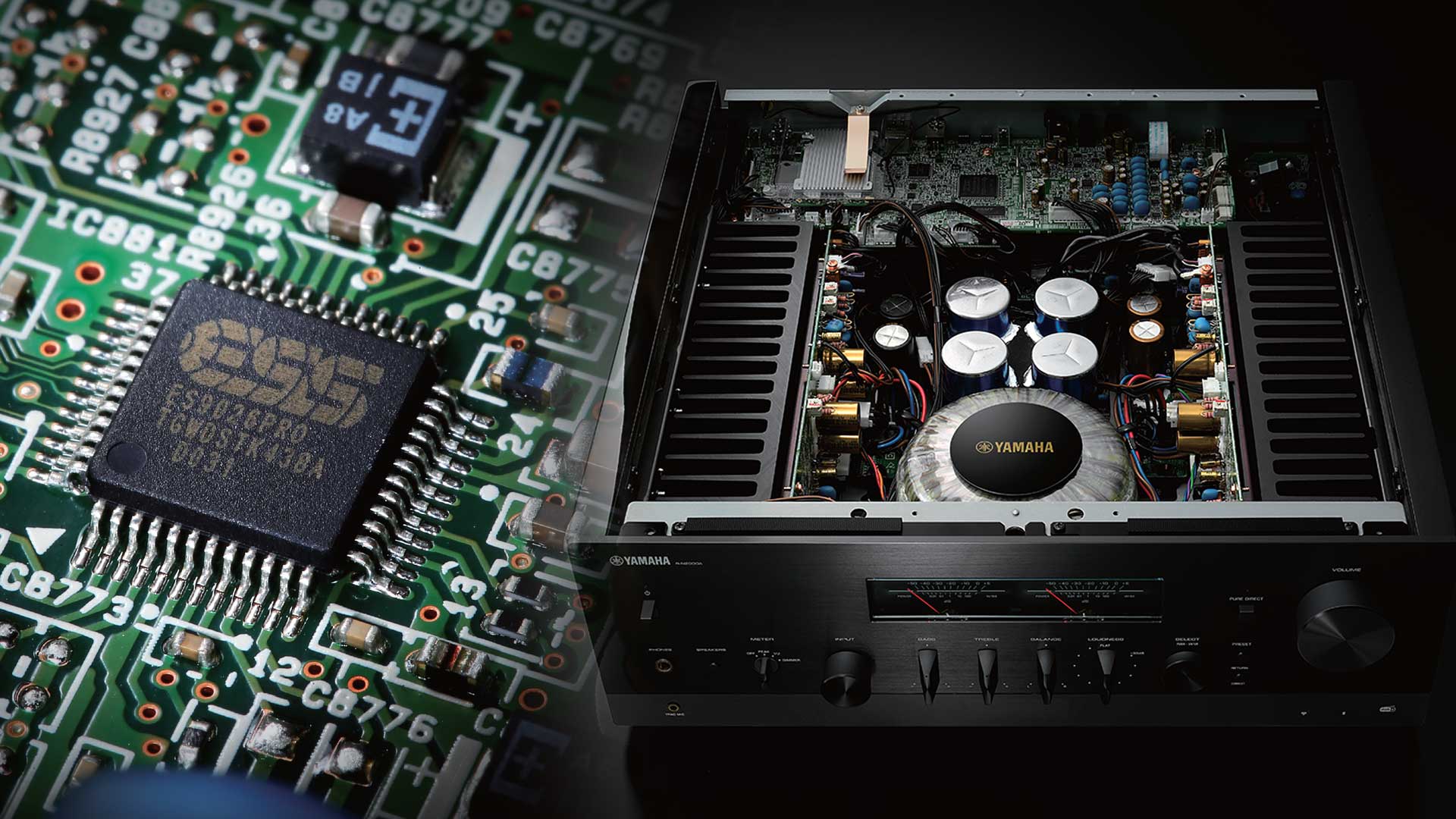
Inside the R-N2000A
Yamaha is adept at creating product lines that take ideas from the top and deliver them in lesser ways for ranges underneath.
Here that extends right through to the fundamental build of the R-N2000A, which uses Yamaha’s ‘Mechanical Ground concept’ to minimise vibration, with the bolts of the feet welded directly to the main chassis, and the large heat sink, power transformer and block capacitors also directly bolted to the chassis. And that power transformer is a large toroid, with a 3mm brass base sandwiched between the transformer and the inner chassis, again to further control vibrations.
The DAC within is the respected ES9026PRO D/A converter from ESS Technologies, and despite Mr Kumuzaya’s concerns the R-N2000A is able to retain a seemingly perfect symmetry in circuit construction, which aims to neutralise tiny voltage fluctuations, creating a silent background on which the amplifier (receiver, sorry) can weave its magic.
The amplification itself is not specified, but is certainly Class-AB, although the power amp circuitry and power supply are completely independent from the ground (which made us wonder if something hybrid was going on; we’re advised not). This floating and balanced design provides isolation from external ground noise, though that too should be minimised by some of the ‘Low Impedance’ concepts inherited from the flagship 5000 Series amplifiers, where heavy gauge wires for the ground connections ensure a solid connection for those parts which are grounded.
Good luck working out the power rating. Between Yamaha’s website and the R-N2000A’s manual, the power rating is quoted 17 different ways, yielding figures of 2 x 90W, 98W, 100W, 120W, 130W, 145W, 185W, 190W or 215W depending on how it’s measured. The most ‘hi-fi’ specification seems to be 2 x 90W into 8 ohms or 2 x 145W into 4 ohms, both measured across the full audio spectrum with 0.07% THD.
Interestingly the A-S3200, at double the price, offers only slightly more power, rated at 100W/150W into 8/4 ohms with that same 0.07% THD, while its quoted ‘Maximum Power’ is actually lower, 2 x 170W compared with the cheaper R-N2000A’s 2 x 190W. Strange. Perhaps we should just do what we came for, and give it a good listen.
- Our advice: how to choose and set up a stereo amplifier
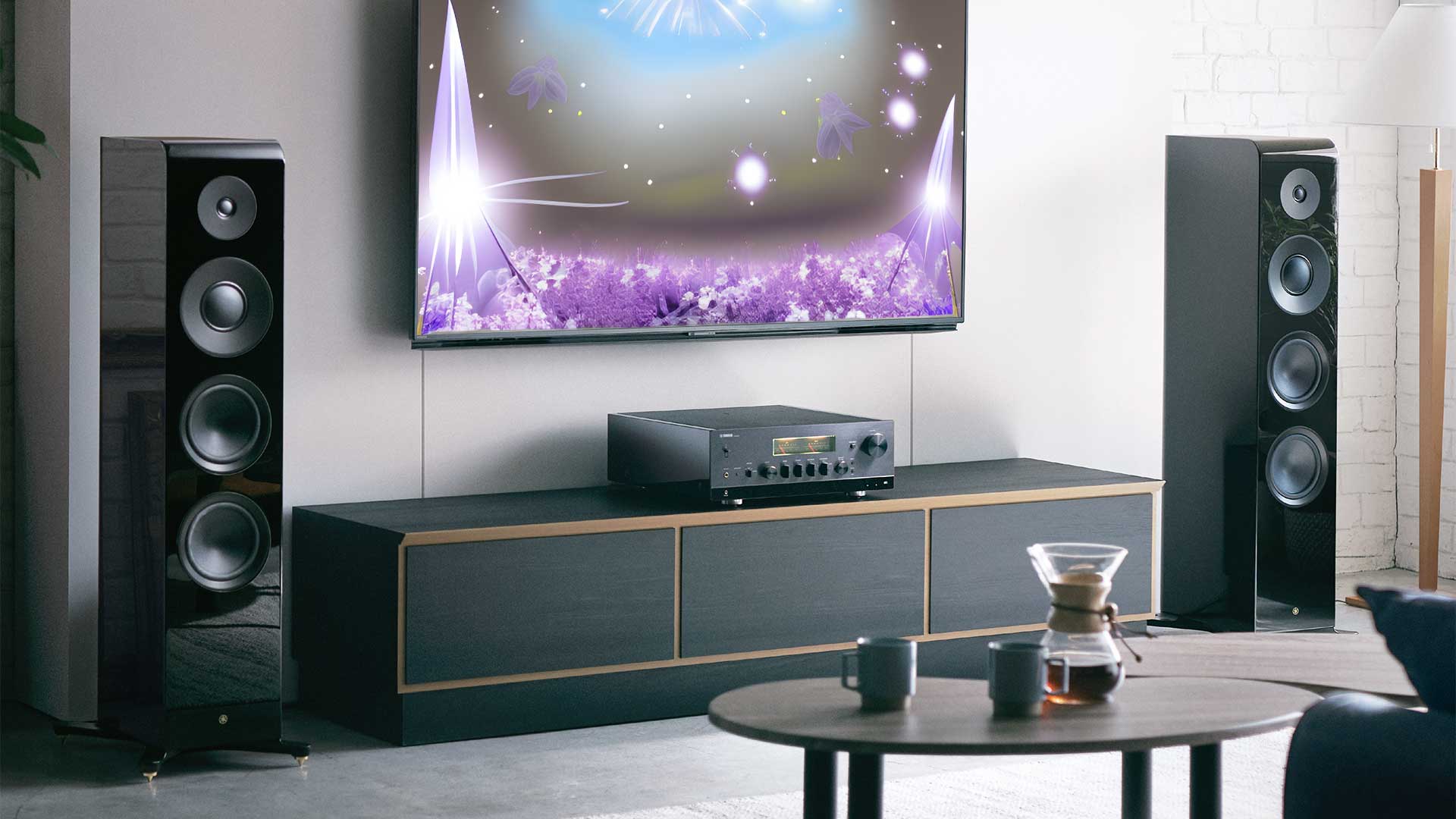
Performance
We took advantage of this amplifier’s extended stay, using it in multiple listening sessions from multiple sources.
Tidal Connect proved a particularly easy way to stream at high quality. The latest in the Dylan bootleg collection, ‘Fragments’, pulsed and jangled forth fully etched and clear, not a jot of softness from the stream. This album showed in Tidal on our device as a Masters album, though MusicCast indicated 16-bit/44.1kHz playback – full CD but no more, so presumably there’s no MQA in the Yamaha to ‘unfold’ the high-res.
But it didn't seem required; the Tidal stream fully opened up the quality of Peter Gabriel’s The Court (Dark Side mix), revealing the depth and breadth and detail in this delightful recent ‘New Moon’ release. And all this with the convenience of browsing from our smartphone in the native Tidal app, simply selecting the MusicCast ‘room’ as the app’s output.
To ensure full possible file quality, we played a huge amount of music from USB-B, attached to our Mac Mini music machine. In this scenario the Yamaha proved a solid and reliable deliverer of delights during the many hours we listened, and we confirmed high-res capability up to and beyond 24-bit/192kHz.
The uncompressed 24/96 version of McCartney’s ‘McCartney’ was a joyfully crisp listen, much of it recorded with mikes and guitars plugged directly into a borrowed Studer, so that instruments and voices sounded gloriously crisp against the silence of these remasters; it’s enough to distract us from the vinyl original. Cranked nicely, the snare snaps on Every Night were not only thrillingly isolated in the right channel but delivered with impressively realistic crack.
As the layers were building through this track, every element could be examined individually, nothing fell at the wayside compressed under the weight of another, yet the whole drifted along on its masterful melody, so that we enjoyed a window into the recording process, but without polishing away the magical sheen of the music.
This proved an ongoing gift of the R-N2000A – complete clarity, but without becoming clinical, revealing the detail but never restraining the dynamics to do so. Indeed, as that snare crack had intimated, there’s more than enough power here for either whip-crack dynamics over an acoustic background, or just for retaining clarity while partying with pop or rock at good-time levels.
The former acoustic clarity was further proven with some high-res Holst, the BBC National Orchestra of Wales, with The Morning of the Year: Mating Dance rolling with timpani in the deep before suddenly surging forth with simultaneous brass, woodwind, male and female choirs – this is an extreme arrangement, yet the R-N2000A’s toroid and capacitor reserves laughed it off, even allowing enough acoustic space over the top of it all for the cymbal crashes which punctuate the climax at stage right. Phew; we needed a rest after that one.
A play through Alex The Astronaut’s Already Home had us quite emotional, but to be honest it’ll do that through a 20mm radio speaker so that’s no real test.
We ran the 24/96 version of ‘Buena Vista Social Club’ – it’s a completely different mix to the CD, and was more than usually revealed by the Yamaha as being quite an interesting variation of ping-pong placement and organic mix from track to track; sometimes separate pictures in the mix with little overall acoustic to meld them together, other tracks clearly performed as an ensemble, with stereo-pair miking across a group. Again the combination of insight and musicality was thrilling enough through this amplifier (receiver) that we enjoyed the album to its end.
The phono stage was just as fun, performing exceptionally well. We played the first two sides of Nick Mason’s ‘Saucerful of Secrets Live at the Roundhouse’; the Blu-ray of this gig is also recommended, and there’s much to be said for its surround mix, but the vinyl still captures the powerful performance, here met by an adoring crowd while the trippy bleeps and effects ricochet between stereo speakers during the underground mystique of Interstellar Overdrive, Astronomy Domine and 20-odd (some really odd) other under-recognised early Floyd tracks.
The pop from the kick drum was a full-force thwack. Frankly, you’d not pick the sound of this album from our Thorens turntable through the Yamaha’s phono stage as even being vinyl; the soundstage never cracked, compressed or sounded curtailed, delivering a full audio spectrum throughout, and tracking solidly through the many dense and deep moments in this set. Vinyl fans won’t go wanting here, assuming moving-magnet is all you need.

Verdict
Know what we did? There’s so much else going on in the R-N2000A that we forgot to try the tuner section – the very bit which defines the R-N2000A as a receiver rather than an amplifier. There are FM and DAB+ tuners available, and internet radio too, which we did try through MusicCast, successfully streaming our local community radio station in glorious 320kbps.
Radio is a mere bonus when you get all the performance joys here: a high-quality amplifier that takes its design cues from Yamaha’s even higher analogue-only models, yet here gaining not only a digital section with DAC and inputs but also a full wireless and multiroom streaming platform in MusicCast.
Indeed as smart amplifiers go, the R-N2000A brings Yamaha leaping into a remarkably underpopulated category – medium to high-end smart amplifiers. It seems many higher-end manufacturers are still thinking their purist customers
will want digital and streaming kept separate from their control electronics and power sections.
The convenience plus confidence of the R-N2000A should make them think again.

Jez is the Editor of Sound+Image magazine, having inhabited that role since 2006, more or less a lustrum after departing his UK homeland to adopt an additional nationality under the more favourable climes and skies of Australia. Prior to his desertion he was Editor of the UK's Stuff magazine, and before that Editor of What Hi-Fi? magazine, and before that of the erstwhile Audiophile magazine and of Electronics Today International. He makes music as well as enjoying it, is alarmingly wedded to the notion that Led Zeppelin remains the highest point of rock'n'roll yet attained, though remains willing to assess modern pretenders. He lives in a modest shack on Sydney's Northern Beaches with his Canadian wife Deanna, a rescue greyhound called Jewels, and an assortment of changing wildlife under care. If you're seeking his articles by clicking this profile, you'll see far more of them by switching to the Australian version of WHF.
